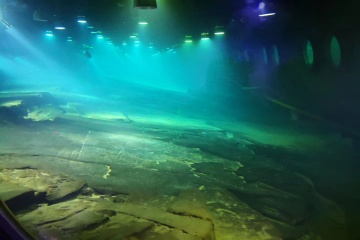The Baiheliang Underwater Museum is a unique and culturally significant site located in Fuling District, Chongqing. It is the world’s first underwater museum, renowned for its ancient hydrological inscriptions and profound cultural heritage. Known as the "Treasure of Yangtze River Culture," it is an important site for ancient hydrological observation in China.

The museum is situated on the southern bank of the Yangtze River, near the confluence of the Yangtze River and the Wu River. The specific address is 185 Baiheliang Avenue. To get there, tourists can take bus Fuling 113, Fuling 119, Fuling 125, Fuling 203, Fuling 302, Fuling 306, or Fuling 307 and get off at Baiheliang Stop. There is no nearby metro station, so public buses are the main mode of transportation.
Baiheliang, also known as White Crane Ridge, is a natural stone ridge that stretches approximately 1,600 meters in length and averages 15 meters in width. It has a history of over 1,200 years, dating back to the Tang Dynasty (618–907). The ridge was an important site for hydrological observation, recording changes in the Yangtze River's water levels. It is considered the world’s oldest hydrographic survey device, predating China’s first official water level gauge in Wuhan by more than 1,100 years. The name “Baiheliang” originates from the natural stone ledge where white cranes frequently gathered, spreading their wings and frolicking. Ancient legends suggest that during the Northern Wei period, the immortal Erzhu Zhen practiced his ascension to the heavens on the back of a white crane from this location.
The Baiheliang Underwater Museum consists of a ground exhibition hall and an underwater viewing area. The ground exhibition hall is divided into three levels. The first level serves as a reception and functional space, featuring an information desk, an introductory hall, a waiting area for underwater tours, and a souvenir shop. The second level functions as the main exhibition space and is divided into four thematic areas: “Water – Hydrological Observations in the World’s Great River Civilizations,” “Ruler – The Scientific Value of Baiheliang’s Inscriptions,” “Poetry – The Cultural Value of Baiheliang’s Inscriptions,” and “Museum – The World’s First Underwater Inscription Museum.” The third level offers a panoramic view of the Yangtze River.
The underwater viewing area comprises four sections: a sloping corridor, a horizontal corridor, a viewing corridor, and the original location of the underwater inscriptions. Constructed using pressure-resistant metals and featuring 23 glass observation windows, this area allows visitors to closely examine and study the inscriptions on Baiheliang. Visitors descend via a 91-meter-long escalator, travel through a 150-meter horizontal corridor, and arrive at the viewing corridor located 40 meters below the surface of the Yangtze River. Over 10,000 lights arranged in six rows illuminate the underwater inscriptions, ensuring clear visibility.
The Baiheliang Underwater Museum is not only a place to inherit hydrological culture but also a great destination for visitors to learn about ancient Chinese hydrological observation techniques. The museum showcases a large number of stone inscriptions and cultural relics related to the Yangtze River's hydrology. These inscriptions, featuring notable figures like Song dynasty poet and calligrapher Huang Tingjian, have earned Baiheliang the title of the “Forest of Steles Underwater.”
The museum is open year-round. The best time to visit is during spring and autumn. The entrance fee is 60 RMB per person. Visitors can drive from downtown Chongqing via the Hu-Yu Expressway for about 1.5 hours or take a high-speed train from Chongqing North Station to Fuling, then transfer to a scenic area shuttle.
Some areas in the museum can be slippery, so it is advisable to wear comfortable shoes. Visitors should also avoid touching the cultural relics to protect the heritage and protect the environment by not littering.
The Baiheliang Underwater Museum offers a unique and educational experience for visitors, combining ancient hydrological wisdom with modern preservation techniques. It stands as a testament to China’s rich cultural heritage and scientific ingenuity.




































